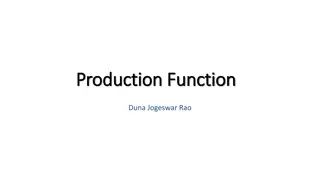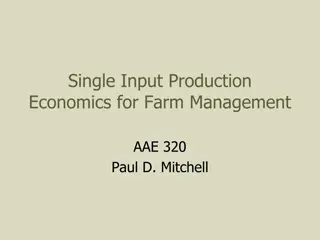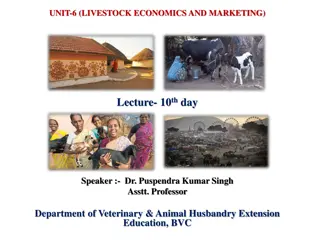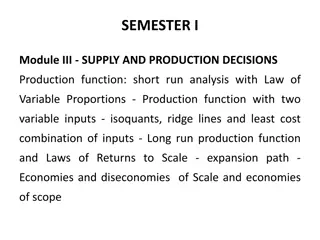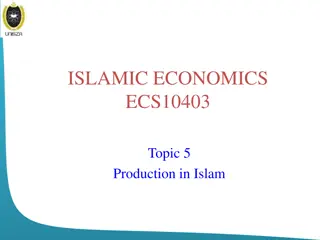Laws of Production in Economics
The content discusses the laws of production in economics, including the law of variable proportion in the short run and the law of returns to scale in the long run. It explains the concepts of total product, average product, and marginal product, along with the stages of production. The law of variable proportion emphasizes the relationship between input changes and output levels. In contrast, the law of returns to scale examines how changes in all input factors impact overall production in the long run. The content also highlights the assumptions and applicability of these laws within economic production processes.
Download Presentation

Please find below an Image/Link to download the presentation.
The content on the website is provided AS IS for your information and personal use only. It may not be sold, licensed, or shared on other websites without obtaining consent from the author. Download presentation by click this link. If you encounter any issues during the download, it is possible that the publisher has removed the file from their server.
E N D
Presentation Transcript
Sandeep Sundas Dept. of Economics Kaliyaganj College
Production is an activity that generates income in exchange of the services. Production is a process of combining different inputs to yield a specific output. Q=f(L,K) which stands at Q as the level of output, L and K as labour and capital respectively.
Law of variable proportion or short run production function. Law of returns to scale or long run production function.
This law is also called the law of proportionality. The law state that change in output due to the change in any one input by the same rate. Leftwitch the law of variable proportion states that if the inputs of one resource is increased by equal increment per unit of time while the inputs of other resources are held constant, total output will increase, but beyond some point the resulting output increase will become smaller and smaller.
Units of variable input 1 2 3 4 5 6 7 8 9 TP AP= (TP/L) MP = (dTP/dL) Stage 4 10 21 40 55 60 63 64 63 4 5 7 10 11 10 9 8 7 4 6 11 19 15 5 3 1 -1 Stage 1 MP>AP MP increases more than AP Stage 2 MP increases but at slower rate. TP is maximum Stage 3 MP<0 MP declines
The law is based on no change in the technology. All units of the variable factor are homogenous. Only one factor is variable, others remaining constant. The products are measured in physical units. Example quintals, tonnes etc. It is assumed that all variable factors are equally efficient. Only applicable under short run.
In the long run all factors of production are variable. The scale of production can be changed by changing the quantity of all factors of production. Koutsoyiannis the term returns to scale refers to the changes in output as all factors change by the same proportion. Leibhafsky returns to scale relates to the behavior of total output as all inputs are varied and is a long run concept. The law states that change in output due to the change in all the inputs by the same rate and same percentage.
Increasing returns to scale Decreasing return to scale Diminishing returns to scale.
Labour Capital Total output Increase in the rate of output 4 6 8 10 10 10 10 7 5 4 Nature of returns to scale Increasing returns to scale 1 2 3 4 5 6 7 8 9 10 1 2 3 4 5 6 7 8 9 10 4 10 18 28 38 48 58 65 70 74 Constant returns to scale Decreasing returns to scale
Increase in output is more than increase in input. This is also known as law of diminishing costs. This is because the cost per unit of output falls as the industry expands. Causes of increasing returns to scale Indivisibility of factors of production Division of labour and specialization Internal and external economies of scale. a. b. c.
Internal economies of scale are those economies which occurs to the firm itself when it expands its output. External economies are those when the whole industry grows larger and firm benefit from lower long run AC. Internal economies. Reduce in the fixed cost. Cost reduction due to specialization. Less cost for raw material. Now External economies Outside factor e.g. Taxes. Reduction in cost due to proper transport. a. b. c. a. b.
increase in the output is less than the increase in the input. Occurs due to difficulties in management, coordination and control
increase in the output is equal to increase in input. This is called linear homogenous production function
Returns to scale Increasing returns to scale Constant returns to scale Decreasing returns to scale 1. 2. 3.
Isoquants Isoquants shows the different combination of labour and capital to produce the same level of output.








